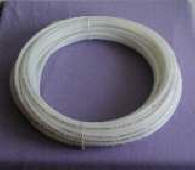|
History of PEX
Tubing
There are three Manufacturing methods
for producing PEX tubing.
"Engel" or peroxide
manufacturing method
"Silane"
manufacturing method
"Electron Beam crosslinking"
manufacturing method
PEX results from chemically joining
individual polyethylene molecules in order to improve
the performance of the original base resin in higher
temperatures. The primary reason for cross-linking
polyethylene (PE) is to raise the thermal stability of
the material under load. This substantially improves
environmental stress crack resistance and resistance to
slow crack growth.
In the late 1950s scientists worked on the structure of
polyethylene to strengthen the connections between the
polymer chains. They developed ways to create additional
ties between the PE molecules through covalent or
chemical bonding. The result was a PE structure that did
not "flow" or move to a softened state as quickly when
the temperature is increased.
PEX Manufacturing Methods
There are three Manufacturing methods
for producing PEX tubing.
1. The "Engel"
or peroxide method employs a
special extruder with a plunger action where peroxide is
added to the base resin and through a combination of
pressure and high temperature the cross-linking takes
place as the tubing is produced.
Back to top
2. The "Silane"
method of PEX production involves
grafting a reactive silane molecule to the backbone of
the polyethylene. The tubing is produced by blending
this grafted compound with a catalyst which can be done
using either the Sioplas method or by using a special
extruder it can be done using the Monosil method. After
extrusion the tubing is exposed to either steam or hot
water to induce the final cross-linking reaction in the
tubing.
Back to top
3. Electron Beam crosslinking takes place when
very high energy radiation is used to initiate molecular
cross-linking in high density polyethylene. This product
is extruded like normal HDPE then taken to an E-beam
facility and routed under a beam or ray in the
accelerator where it is dosed with a specific amount of
radiation to release the hydrogen atoms and cause
polymer cahins to bond or link to the open carbon sites.
Back to top
|
